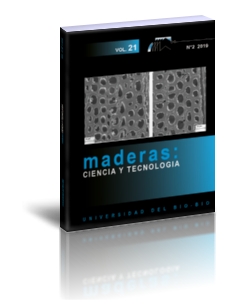Surface properties of novel wood-based reinforced composites manufactured from crushed veneers and phenolic resins
Keywords:
Hardness, surface energy, surface roughness, surface wettability, wood compositesAbstract
This study was performed to determine the surface properties of novel wood-based reinforced composites made from poplar veneers and phenolic resins. The veneers with different thickness (1.8, 4, 6, 8 mm) were finely crushed and then were impregnated with phenolic resins to achieve different resin loading (12, 14, 18%). Finally, they were laminated or random paved to manufacture novel wood-based reinforced composites with different target densities (0.8-1.1 g cm-3). With increased veneer thickness or resin content, the hardness of novel wood-based reinforced composites decreased and their roughness increased. The increase of density contributed to the increased hardness and decreased roughness. The surface wettability of novel wood-based reinforced composites appeared to be closely related to their surface roughness. There was a negative correlation between contact angle and roughness. The novel wood-based reinforced composites prepared by laminated mat formation showed higher hardness, lower roughness than those by random mat formation. Such data of surface properties can be applied to design the novel wood-based reinforced composites products with desired quality and provide basic information for further panel processing.
Downloads
References
Aydin, I.; Colakoglu, G.; Hiziroglu, S. 2005. Surface characteristics of spruce veneers and shear strength of plywood as a function of log temperature in peeling process. International Journal of Solids and Structures 43(20): 6140-6147.
Bekhata P.; Krystofiak, T. 2016. The influence of short-term thermo-mechanical densification on the surface wettability of wood veneers. Maderas-Cienc Tecnol 18(1): 79-90.
Bledzki, A.K.; Mamun, A.A.; Volk, J. 2010. Physical, chemical and surface properties of wheat husk, rye husk and soft wood and their polypropylene composites. Composites: Part A 41(4): 480-488.
Büyüksarı, Ü. 2013. Surface characteristics and hardness of MDF panels laminated with thermally compressed veneer. Composites: Part B 44(1): 675-678.
Candan, Z.; Shaler, M.S.; Heller, J.J.P.; Edgar, R. 2017. Enhancing dimensional stability of oriented strand composites within biorefinery. Maderas-Cienc Tecnol 19(3): 387-398.
Candan, Z.; Hiziroglu, S.; McDonald, A.G. 2010. Surface quality of thermally compressed Douglas fir veneer. Materials and Design 31(7): 3574-3577.
Chung, M.J.; Wang, S.Y. 2017. Mechanical properties of oriented bamboo scrimber boards made of Phyllostachys pubescens (moso bamboo) from Taiwan and China as a function of density. Holzforschung 72(2): 151-158.
Fang, C.; Mariotti, N.; Cloutier, A.; Koubaa, A.; Blanchet, P. 2012. Densification of wood veneers by compression combined with heat and steam. European Journal of Wood & Wood Products 70(1-3): 155-163.
Gindl, M.; Sinn, G.; Gindl, W.; Reiterer, A.; Tschegg, S. 2001. A comparison of different methods to calculate the surface free energy of wood using contact angle measurements. Colloids & Surfaces A Physicochemical & Engineering Aspects 181(1-3): 279-287.
Gungor, N.; Ayrilmis, N.; Kantay, R. 2006. Selected physical and mechanical properties of LVL made from Pterocarya fraxinifolia (Lam.) Spach. Forest Products Journal 56(5): 82-85.
He, M.J.; Zhang, J.; Li, Z.; Li, M.L. 2016. Production and mechanical performance of scrimber composite manufactured from poplar wood for structural applications. Journal of Wood Science 62(5): 429-440.
Hutyrová, Z.; Harničarová, M.; Zajac, J.; Valíček, J.; Mihok, J. 2014. Experimental study of surface roughness of wood plastic composites after turning. Advanced Materials Research 856: 108-112.
Hiziroglu, S.; Jarusombuti, S.; Fueangvivat, V. 2004. Surface characteristics of wood composites manufactured in Thailand. Building and Environment 39(11): 1359-1364.
Hiziroglu, S.; Zarate, S. 2007. Mechanical properties and surface characteristics of colombian wood composites. Journal of Composite Materials 41(18): 2225-2234.
Huang, X.; Kocaefe, D.; Boluk, Y.; Kocaefe, Y.; Pichette, A. 2012. Effect of surface preparation on the wettability of heat-treated jack pine wood surface by different liquids. European Journal of Wood & Wood Products 70(5): 711-717.
Kol, H.S.; Keskin, H.; Korkut, S.; Akbulut, T. 2009. Laminated veneer lumber from Rowan (Sorbus aucuparia Lipsky). African Journal of Agricultural Research 4(10): 1101-1105.
Li, Y. 2014. Effect of woody biomass surface free energy on the mechanical properties and interface of wood/polypropylene composites. Journal of Adhesion Science and Technology 28(2): 215-224.
Li, Z.; He, M.; Tao, D.; Li, M. 2016. Experimental buckling performance of scrimber composite columns under axial compression. Composites Part B: Engineering 86: 203-213.
Liu, R.; Sun, W.; Cao, J.; Wang, J. 2016. Surface properties of in situ organo-montmorillonite modified wood flour and the influence on mechanical properties of composites with polypropylene. Applied Surface Science 361: 234-241.
Liu, Y.; Tao, Y.; Lv, X.; Zhang, Y.; Di, M. 2010. Study on the surface properties of wood/polyethylene composites treated under plasma. Applied Surface Science 257: 1112-1118.
Melo, P. 2014. Influence of veneer thickness on the properties of LVL from Paricá (Schizolobium amazonicum) plantation trees. European Journal of Wood & Wood Products 72(2): 191-198.
Oberhofnerová, E.; Pánek, M.; Garcíacimarras, A. 2017. The effect of natural weathering on untreated wood surface. Maderas-Cienc Tecnol 19(2): 173-184.
Oss, C.J. 1993. Acid-base interfacial interactions in aqueous media. Colloids and Surfaces A: Physicochemical and Engineering Aspects 78: 1-49.
Shi, S.Q.; Gardner, D.J. 2001. Dynamic adhesive wettability of wood. Wood & Fiber Science 33: 58-68.
Santos, S.N.C.; Gonçalves, D. 2016. Variations in wettability on heat-treated wood surfaces: contact angles and surface free energy. Maderas-Cienc Tecnol 18(2): 383-394.
Stehr, M.; Gardner, D.J.; Wålinder, M.E.P. 2001. Dynamic wettability of different machined wood surfaces. The Journal of Adhesion 76(3): 185-200.
Unsal, O.; Candan, Z. 2008. Moisture content, vertical density profile and janka hardness of thermally compressed pine wood panels as a function of press pressure and temperature. Drying Technology 26(9): 1165-1169.
Wålinder, M.E.P. 2002. Study of Lewis acid-base properties of wood by contact angle analysis. Holzforschung 56(4): 363-371.
Yu, H.; Fang, C.; Xu, M.; Guo, F.; Yu, W. 2015. Effects of density and resin content on the physical and mechanical properties of scrimber manufactured from mulberry branches. Journal of Wood Science 61(2): 159-164.
Zhang, Y.; Huang, X.; Zhang, Y.; Yu, Y.; Yu, W. 2017. Scrimber board (SB) manufacturing by a new method and characterization of SB’s mechanical properties and dimensional stability. Holzforschung 72(4): 283-289.

































